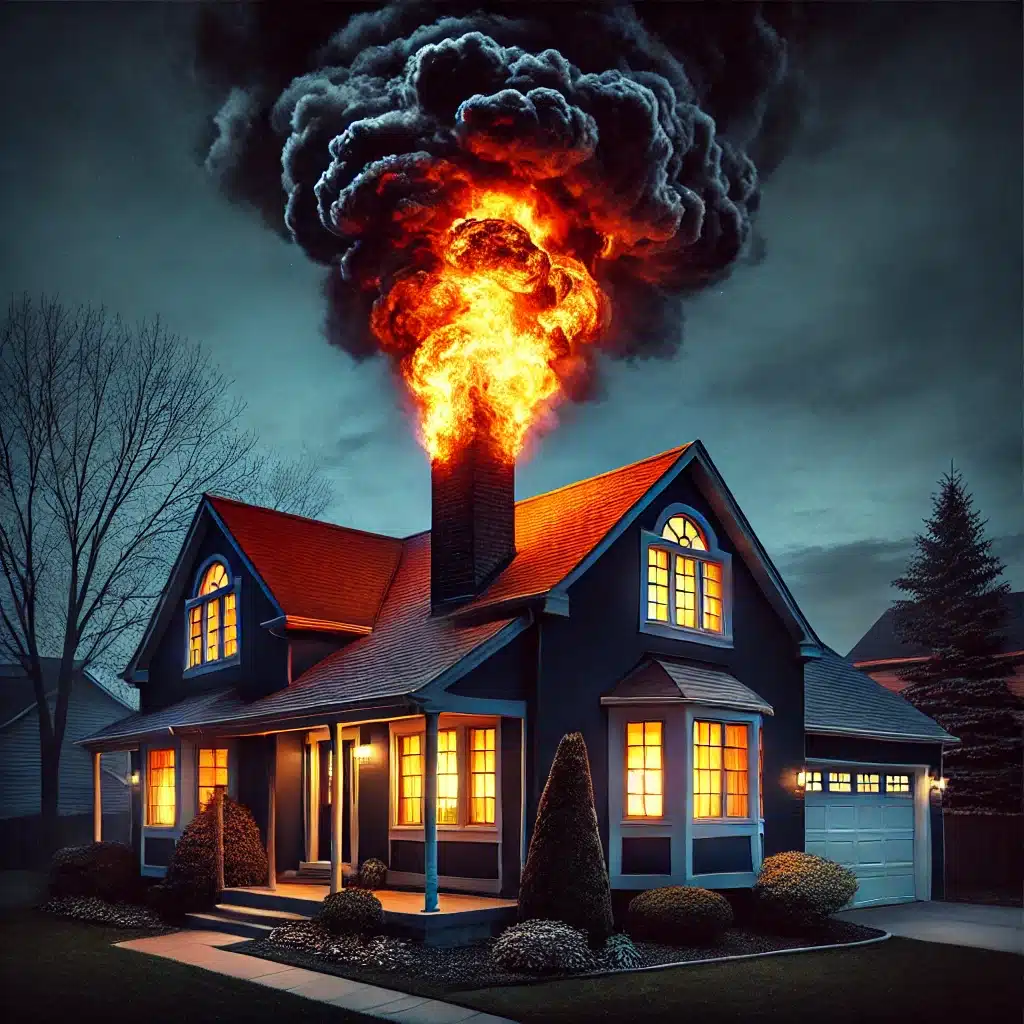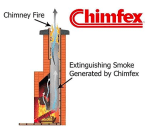Learning how to put out a chimney fire is critical for every homeowner with a fireplace. These hidden dangers can escalate quickly, endangering lives and property.
This guide offers practical steps and safety tips to detect and extinguish a chimney fire effectively. Stay prepared and ensure your home remains a safe haven against such fiery threats.

Key Takeaways:
- Recognize the signs of a chimney fire early, such as loud cracking sounds or intense smoke.
- Ensure regular chimney maintenance and inspections to prevent fires.
- Learn the correct use of chimney fire extinguishers and other safety devices.
Contents
About Chimney Fires

What is a Chimney Fire?
A chimney fire occurs when combustion residue on the inner walls of the chimney flue ignites. These residues, often creosote—a byproduct of burning wood—are highly combustible. A chimney fire can vary in intensity; some blaze unnoticed while others can be explosively loud and dangerous.
Recognizing the Signs of a Chimney Fire
Detecting a chimney fire early is key to effectively managing the situation. Here are some clear indicators:
- Sounds: A loud, rumbling sound that resembles a freight train or airplane.
- Sight: Dense, dark smoke and intense, bright orange flames emerging from the chimney top.
Preventative Measures
Regular Maintenance and Inspection
Annual chimney inspections and cleanings are essential to prevent the buildup of creosote and other flammable substances. Consider the following:
- Frequency of Cleaning: The National Fire Protection Association (NFPA) recommends at least annual inspections and cleanings after each cord of wood burned.
- Choosing a Chimney Sweep: Ensure the sweep is certified by the Chimney Safety Institute of America (CSIA).
| Maintenance Task | Description | Frequency |
|---|---|---|
| Visual Inspection | Check for structural integrity and obstructions. | Annually |
| Creosote Removal | Professional cleaning to remove buildup. | As needed |
Installing and Using Chimney Safety Devices
Enhancing your chimney with safety devices can significantly reduce the risk of a fire. Key devices include:
- Chimney Liners: Provides a protective barrier between the heat and combustible parts of your home.
- Chimney Caps: Prevents debris and animals from entering the chimney, reducing blockage risks.
Emergency Actions and Solutions
Immediate Steps to Take When a Chimney Fire Occurs
If you suspect a chimney fire, act immediately to ensure your safety and minimize damage:
- Evacuate: Ensure all household members leave the home safely.
- Call 911: Report the fire even if you think it has gone out.
- Close Air Intakes: Reduce the fire’s oxygen supply by closing any air intake vents and the glass doors of a fireplace.
Using Chimney Fire Extinguishing Products
In the event of a chimney fire, having the right type of extinguishing product can make a significant difference. Products like Chimfex can suppress a fire in seconds, potentially saving your home and lives. For more information on Chimfex, visit their product page here.
Post-Fire Procedures
After a chimney fire has been dealt with, it’s crucial to follow up with proper procedures to ensure your chimney is safe to use again:
- Inspection and Repair: Hire a professional to inspect for any structural damage.
- Future Prevention: Review what caused the fire and implement stricter maintenance routines.
This comprehensive approach to dealing with chimney fires ensures not only effective management but also emphasizes prevention, helping keep your home safe from one of the most hidden dangers it might face.
Advanced Preventative Techniques
In-depth Maintenance Tips Regular and thorough maintenance is vital. Here’s what you can do to ensure a safer chimney:
- Monthly Visual Checks: Look for any signs of wear or blockage even outside of the usual annual inspection.
- Wood Choice: Only use dry, seasoned wood which burns cleaner and reduces creosote buildup.
| Type of Wood | Burn Quality | Notes |
|---|---|---|
| Hardwood | High | Ideal for a longer, hotter burn |
| Softwood | Lower | Good for kindling but creates more creosote |
Chimney Fire Suppressants Discuss the different types of suppressants and how they can help in an emergency. Include products like fire suppressant balls and sprays, detailing how they can be strategically placed for quick access and use.
Educational Resources and Training
Understanding Fire Dynamics in Chimneys Educating yourself and your household about fire dynamics can significantly reduce the risk of chimney fires. Consider attending a local fire safety workshop or viewing educational content online.
- YouTube Video Resource: Watch “Chimney Fire Demonstration at Training School” for a practical understanding of chimney fire behavior.
Community Safety Programs Many communities offer programs that focus on fire safety. Participating in these can provide practical tips and sometimes even hands-on training.
Frequently Asked Questions
How can I tell if my chimney is on fire?
Look for signs like loud cracking, popping, or a low rumbling sound similar to a distant train.
What should I not do during a chimney fire?
Do not attempt to extinguish the fire with water as it can cause severe structural damage to the chimney.
How often should I have my chimney inspected to prevent fires?
The National Fire Protection Association recommends annual inspections or more frequently if you use your fireplace regularly.
What are the best products to keep on hand in case of a chimney fire?

Products like Chimfex can be used to control and suppress chimney fires quickly. For options and safety tips, visit here.
Concluding Thoughts
Staying proactive about chimney fire safety is more than just a precaution; it’s a necessary part of home maintenance that can prevent potential disasters.
By incorporating regular inspections, understanding the appropriate use of fire suppressants, and educating yourself about fire safety, you can keep your home safe and warm, especially during the colder months.
Remember, the key to effective chimney fire management is preparation and education. In addition, ensure your home is equipped with the right tools to prevent and respond to chimney fires effectively.